My Automotive Hobby - Overview and History
My 2nd greatest passion in life
Introduction
The two great passions running nearly the full length of my life have been music/electronics and all things automotive/mechanical. These just happen to be the very same passions in my dad's life, outside of our collective interests in family and business. My views on the world at large were influenced by my upbringing, and this is where I will start in the telling of my tale . . .
My dad sitting on back of his father's car, age 2 (Regina, 1933):
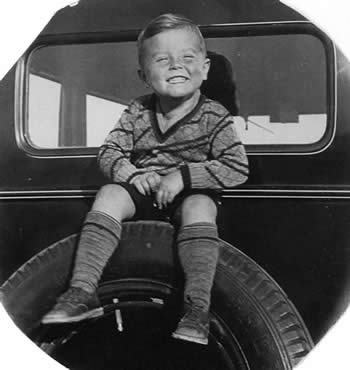
My dad and his motorized bicycle, built at age 14 (Regina, 1945):
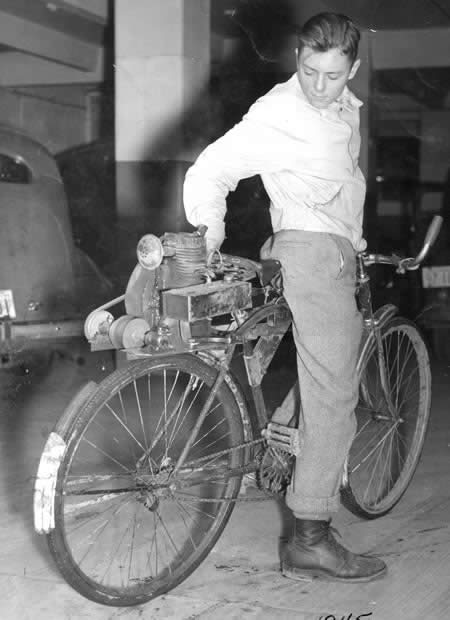
My dad's motorized go-kart, with a 38mph top speed, built at age 15 (Regina, 1946):
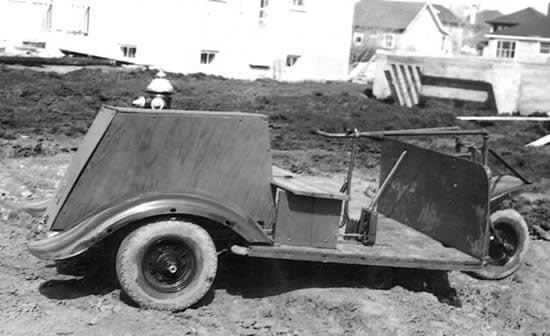
Click here for a Vancouver Sun Autobiography on my dad and this car - June 15, 2001
My dad, washing his new '49 Ford, at age 18 (Regina, 1949):
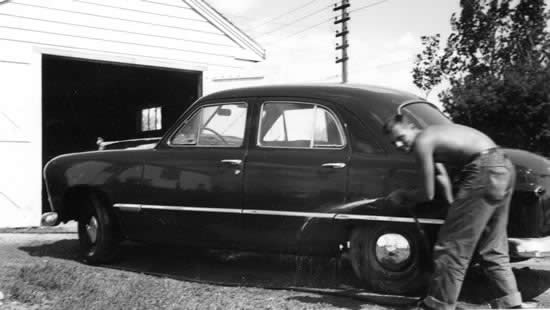
My dad, with his '53 Chrysler Crown Imperial, at age 24 (Montreal, 1955):

My mom posing in front of some of the race and show cars that were competing at the temporary circuit on the tarmac of the Abbotsford, BC airport in 1957:
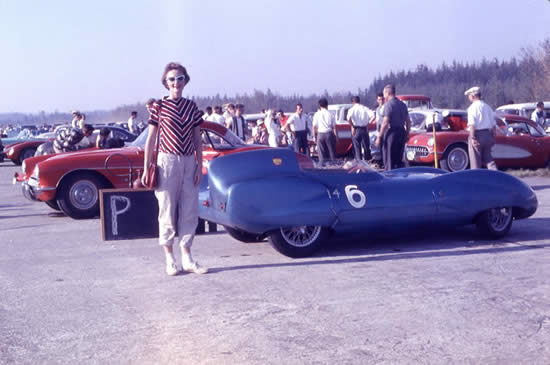
My older brother, Douglas, and my dad with his '60 Mercury Monterey (Vancouver, 1961):
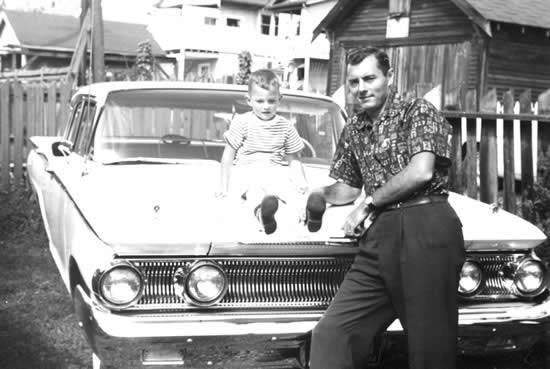
Posing in front of our 'bad boy' Mercedes 280SE in grade 5 (1972):
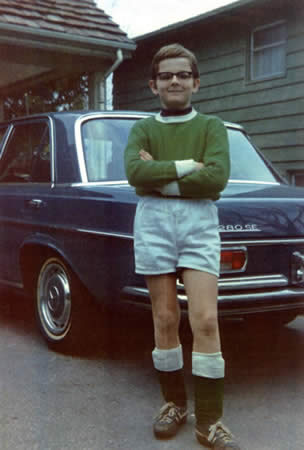
After my dad's steadfast loyalty to American made V8 powered sedans in the 1950s and 60s, he moved up market in 1969 into a long line of Mercedes Benz passenger cars, starting with the purchase of a 280S 4 door sedan in 1969 and then upgrading to the mechanically injected 1970 280SE which produced a healthy 185hp at a 10.8:1 compression ratio using 2.8 litres of displacement - enough to propel the 3500lbs sedan down the highway in about 8.5s from 0-60mph, ultimately achieving a top speed just shy of 130mph. It was a symphony of mechanical noises as its single overhead cam engine wound its way up the rpm range.
When the OPEC oil crisis hit full force in the mid 1970s, my dad's response was to acquire a 1974 Mercedes 240D diesel sedan, complete with its oil burning 65hp engine and its 0-60mph time slip of 22 seconds. What an unrefined car that was - even if it was a mileage champ. You had to warm up the cylinder head glow plugs before cranking it when it was cold, only to be met by a terrible racket of dieseling noise and dirty black exhaust gas (and smell) until it warmed up. There was little use attempting to put the car in drive until then, as it would just stall until operating temperatures were obtained. Aside from these attributes, it was also taxi-cab yellow.
After torturing himself with this car for a year, dad upgraded to a slightly improved 1975 300D diesel with its 88hp engine, and then, after realizing that it was still a bit of a pig, used his engineering know-how to improve matters via the addition of a turbo-charger, which actually did make a noticeable difference, allowing the engine to put out around 120hp.
He bought a much more advanced 1981 300SD diesel sedan which was factory turbo-charged and quieter, factory rated at 115hp. That car was perhaps the first truly all-round drivable diesel I had the pleasure of driving (these days diesels are not only drivable, but almost indistinguishable from gas powered cars as quiet, convenient and efficient - and with the pending introduction of urea-injection, the tail pipe emissions will be as good as gas cars as well). This was the car I started to drive my new girlfriend, Cheryl, around in when we were in Vancouver together in the summers during college.
As a side note, dad is the only person I have heard of that has gone to the effort of equipping some of his later Mercedes diesels with nitrous oxide and propane injection - again, for more power and acceleration. A true gearhead (with a green conscience).
Our go-kart in grade 6 (1973)
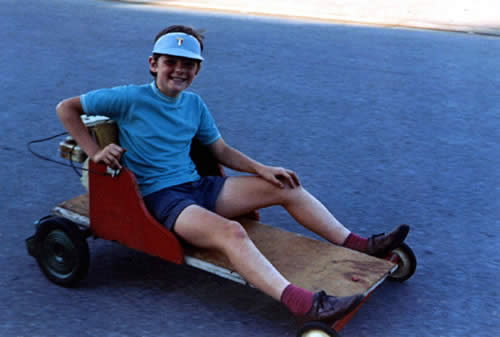
My dad, who had built his own motorized go-kart as a child, initially built this go-kart for my brother, Douglas, out of a used Briggs & Stratton lawn mower. It was a basic and quite usable design - with the blades of the mower cut off by a cutting torch by the local lawn mower shop and the tubular push handle removed. All that was then required to convert the lawn mower into a go-kart was the addition of the plywood chassis and some longer engine bolts to sandwich the chassis between the engine and mower sheet metal. The pulley tensioner was re-routed towards the front, along with the throttle, and this little go-kart could manage 2-3mph around the lawn and culdesac.
I took a shine to this little contraption the moment I saw it, and after Douglas got bored of it I took over possession and quickly set to work trying to make it go faster. This was accomplished quite simply by increasing the diameter of the engine drive pulley and then using a longer belt - parts that were readily available up on Dunbar Street from the Quick Service Hardware store. The only problem with changing the gear ratios was that the little 2hp engine could barely make it up the local hills around our home once gearing allowed speeds close to 10mph. The foot steering also got a little sensitive at those speeds.
A sketch of a dragster I made in grade 6 (1973):
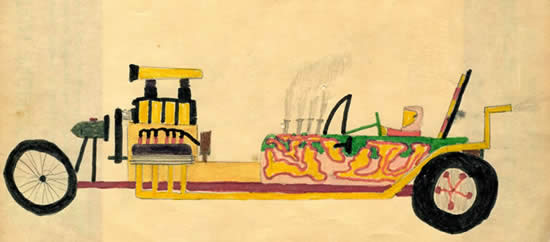
My mini-bike in grade 9 (1976)
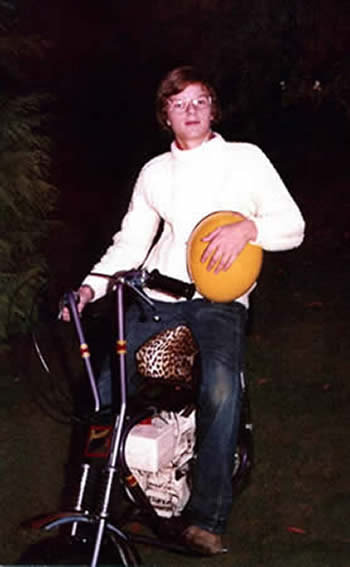
Again, my brother Douglas, being the eldest son, broke ground by building a mini-bike in grade 9 at Point Grey high school in the industrial education shop with Mr. Bernoe. What a cool thing to do at school - but by the time I got to Pt. Grey the automotive shop had been converted into a general purpose woodworking and metalworking shop and building mini-bikes was no longer allowed. Douglas had secured all of the parts required for the completion of his mini-mike from a now defunct mini-bike and go-kart shop on Marine Drive in Vancouver, including a nice 4hp Tecumseh engine. I was allowed to ride his mini-bike on occasion, but it wasn't until he crashed it and bent the front forks, and again got bored of it, that my opportunity arose.
For my 14th birthday in grade 9 my dad took the 4hp Tecumseh engine up to the Dunbar motorcycle shop and married it to a gorgeous new mini-bike frame, complete with a full suspension system. It was metallic blue and I fell in love with it immediately. I ended up re-painting it metallic purple, and experimented with various modifications including welding up a high performance exhaust system for it, increasing the compression ratio of the engine by installing a thinner head gasket, and changing the throttle sensitivity. It was quite a speed demon by the time I was finished with it - I sold it to feed my burgeoning stereo hobby.
I wrote extensively in my 'Some Childhood Memories' book about these matters as well as the general Spratt family car culture that I spent my formative years immersed in. Along with a car-crazy father and the above mentioned go-kart and mini-bike that I upgraded and modified over my elementary and high school years, I was a typical kid that longed for the day I would receive my drivers license and then acquire my own 4-wheeled transportation devices. And again, like any other hot-blooded teenager who learned to wrench at an early age, I read Car & Driver, Road & Track, and Hot Rod magazines, cover to cover each month, allowing my fertile imagination to plan every detail of my future automotive hobby.
Here is a summary of the more interesting cars that I have owned over the years and some stories around them . . .
1968 Chevy Belair (owned 1981)
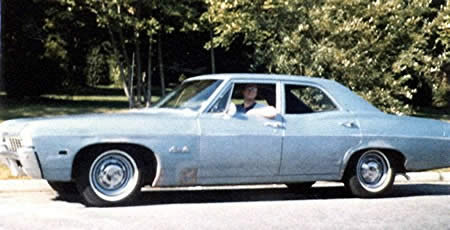
My first automotive purchase was in 1981 (the summer between 2nd and 3rd year university) of a 1968 Chevy Belair with a 307cid V8 engine and a 2-speed powerglide transmission - and drum brakes on bias ply tire all round - for $600 from a teacher who ran a shop class at a local high school. This particular car had its engine rebuilt recently as part of a high school automotive class project. Even then, there were a lot of things that were in need of attention and I ended up spending a big part of that summer fixing it up, and also attempting some bodywork. I sold it at the end of that summer for $1000. It was my first taste of American 'iron'.
For more photos and information on this car, see my 1968 Chevy Belair web page.
1983 VW Rabbit GTI (owned 1983-1987)
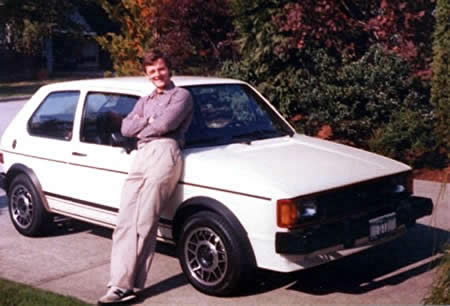
This the car that I have the strongest emotional bond to: my first 'new car' purchase, the car I dated Cheryl with, and the one I traveled in over to Victoria so many time to visit her, the car we drove together to California in, the car we took on our honeymoon together, the first car I really upgrade and modified, etc. And it was such a simple and pleasurable car too.
Each of the Spratt kids had an 'agreement' with our parents - if we managed to scrape through and obtain an undergraduate university degree they would help fund a car purchase to the tune of $5000. As I completed my 4th year of electrical engineering at Queens U, I spent a lot of time trying to decide what the right choice of car would be, and when I read the rave reviews of the up coming '83 VW GTI in all of the leading automotive magazines (Road & Track - November 1982, Car & Driver - November 1982, Motor Trend - November 1982) there was no doubt left in my mind that I had to be one of the first Canadians to own a hot shoe box VW GTI - for a grand total of $10,500.
I had called the Vancouver Clarksdale VW dealer from Kingston, Ontario in the winter of 1982 to put a refundable deposit on the forth coming GTI model, but when I paid a spring break visit to Cheryl in Victoria in early 1983 (she was taking her law school degree at U Vic then), there in the window of the local VW dealer was a perfect white GTI that I just had to have - so I transferred my deposit on the spot and arranged to come back in 2 months time to take possession of my beautiful new car after I graduated.
At the completion of school in April 1983, I drove across Canada in my room-mate's 1975 Mazda RX-3 rotary rocket, with David Brown and Richard Pile, towing an overly large 5'x8' U-haul trailer that was loaded with my life's possessions behind it - basically killing this great little car as we left the peddle maxed out - averaging about 70mph until we hit the Rockies - and then the endless hill climbing started and we tore the bumper clean off the car while burning out the engine. We sold that car in Vancouver after limping with it over to Victoria to pick up my new GTI.
What a great little car the GTI indeed was - the reviewers were right: it was fun, and fast for its day (and well built - a German engineered econo pocket rocket). In today's world the specs for this car are laughable, but back then, at the height of the automotive market identity/gas crisis, this was pure magic for true automotive enthusiasts (almost matching the performance of the Corvette and 911 of its day for a fraction of their prices and with a lot more practical uses for it). I still have fond feelings every time I see an old 1983 or 1984 GTI drive past me on the street.
I did a ton of modifications to this car as I weekend raced it in numerous auto slalom events locally and up at the Westwood race track. I upgraded the wheels and tires, braking pads, changed the springs, shocks, bushings, sway bars, cam shaft, cylinder head cover, headlights, and added an oil cooler and high-end filter system, strut tower braces, a racing exhaust system, a hi-flow fuel pressure regulatory, a bigger throttle body, a high-flow air filter, and upgraded the body with tucked in bumpers, a new white paint scheme for the wheels, bumpers, mirrors, and rear insignia, and a small aero wing. Inside I installed a sub-woofer (very trick for its day), and a high-end tape deck, power amp, in-door speakers with separate tweeters, and matching rear speakers.
To see lots more photos, videos, read automotive magazine reviews, look at performance parts catalogs, and read all about the numerous modifications and racing adventures I engaged in with this car, see my 1983 VW Rabbit GTI web page.
1987 Ford Mustang 5.0 LX (owned 1987-1990)

My purchase of this Ford Mustang took me in a completely different direction from my front wheel drive, small, light, nimble, high quality German engineered, and low powered VW GTI - it was rear wheel drive, heavy, loose, lower quality, and much higher powered. But it had the potential to allow me to live the 60s muscle car experience - something that I thought I had missed out on. For much of my youth, the death of the performance car was a commonly held refrain, and when David E. Davis, the chief editor of Car & Driver magazine, stated that the new V8 Ford Mustang was the literal reincarnation of the muscle cars of days of old, I jumped at the chance to be part of the reborn American muscle car scene.
The first thing I noticed when I picked up the car from the dealer was a horrible shaking of the driver's seat every time I drove over a bump - it turned out that the seat was mounted to a thin sheet of steel that flexed (something I fixed later when building a roll cage for the car). And there was a nasty engine exhaust sound coming from under the dash - which I quickly traced to a gaping hole in the firewall where a lazy factory worker had neglected to attach the steering column gasket. And the wobbly left front fender was missing a major chassis bolt as well. At Ford, quality was certainly not job 1 - in 1987 at least.
Never the less, this particular Ford Mustang was destined to become a heavily modified road and drag racer, complete with a full-on racing suspension and a custom built engine and drive train. This was in the days when no-one dared to attempt to modify a 'computer controlled' car. I took the engine apart myself and ported and polished the cylinder heads, installed over-sized valves, springs, retainers and roller rockers, and tried out a number of different high-lift custom ground hydraulic roller cam shafts, port matched the intake and exhaust system, changed the mufflers, fabricated a spacer/insulator to create a 'cool' intake system, ported and polished the throttle body, installed an adjustable fuel pressure regulator, polished the aluminum valve covers, built a roll cage and chassis bracing/stiffening system, upgraded the brakes, installed a 3.55:1 limited slip diff, and also re-did the audio system inside.
To see lots more photos, videos, review performance tuning results, read magazine reviews, look at performance parts catalogs, and read all about the numerous modifications and racing adventures I engaged in with this car, as well read the story about my lunch time crash into the trees in Stanley Park one sunny day, see my 1987 Ford Mustang 5.0 LX web page.
1987 Mercury Merkur Scorpio (owned 1991-1992)
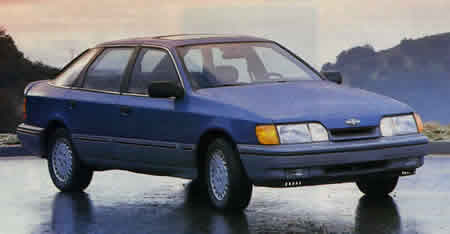
At some point my dad temporarily lost his brand loyalty to German engineered 3 pointed star sedans and traded in his 300SD for a 1987 (Ford) Mercury Merkur Scorpio, and after selling it to me a few years later, he tried an Infinity J30 before finally settling back into the Mercedes fold with the purchase of another diesel sedan from them.
I picked up the Merkur from my dad because I was focusing on some major new home reno projects in 1990 and my Ford Mustang, having been crashed into the trees in Stanley Park, was no longer in my life. I was also in the middle of a failed attempt to build a kit car with the drivetrain components rescued from my Mustang. Finally, I needed some mid-life 'reliable family transportation' (what was I thinking?) and the Merkur looked like the ticket. Boy was I wrong. The car was indeed advanced for its time, and it did offer a long list of standard luxury features in the form of a European sedan for a reasonable price, but it wasn't well supported as an odd-ball European Ford product lost in the Canadian outback, costing a fortune to repair and service.
To read a magazine review, and hear more comments about my brief experience with this unique car, see my 1987 Mercury Merkur Scorpio web page.
1994 Toyota Supra Twin Turbo (owned 1993-1995)
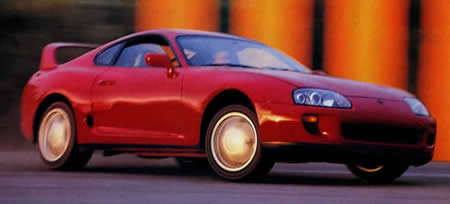
After the general disappointment with my Mercury Merkur, and the bad taste in my mouth after my failed attempt to build a kit car (the kit was garbage and I bailed when I realized the completed car wasn't going to be nearly as nice a I had envisioned), owning the Toyota Supra was an incredible rush - a perfect combination of brutal power and poise. I received the first Supra Twin Turbo in Canada after rushing to place my deposit after reading the wildly positive reviews on the car - just like with my VW GTI a decade before (see Road & Track - August 1993, Car & Driver - September 1993, Motor Trend - July 1993, Motor Trend - August 1993, and Sports Car International - July 1993).
This car felt feather weight light - you could literally place it anywhere you wanted to, and even come into a corner far too quickly, and live to tell about it. Stock out of the box, it would do 0-60mph in 4.5s, and hit a top speed of 180mph (with the governer disabled). And after I finished making some performance upgrades, including a fuzzy logic boost controller that doubled the turbo boost levels, it was also capable of running low 12s 1/4 mile time slips. For $80,000 (at the time), it was a performance bargain. Ultimately, with the birth of my first child and the reality that I really needed a 4 door sedan, I sold it in 1995 and bought/built my Dinan 540i (below).
Like my VW GTI, this car will go down in my personal automotive history book as one of the finest experiences I have had in my motoring life - all of the joy of the GTI (playfulness, simplicity, and quality) with the raw power of the Ford Mustang (actually much more, but you get my point).
To see more photos, videos, read all of the magazine reviews, review performance tuning results, look at performance parts catalogs, and hear about the modifications I made to this fine sports car, see my 1994 Toyota Supra Twin Turbo web page.
1995 Dinan/BMW 540i (owned 1995-2000)
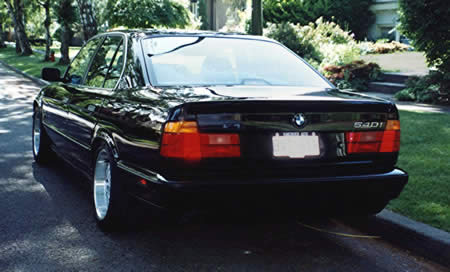
Now this car was one 'bad ass' sleeper sedan (especially for its day) - built in honour of the early AMG Hammer sedans - with its 438hp supercharged engine and 190mph top speed. It sat low to the ground, but otherwise the only clue that something was lurking under the sheep skin was a deep exhaust note. In an all-out drag race to Whistler one day this car pulled away from a 993 Porsche 911 twin turbo (404hp) during a hill climb from 160-300kph. This thing owned the road.
I had read all about Steve Dinan's obsession with modifying BMWs and called him up and asked if he could build me something special. He agreed to work with Weissach (our local Lotus and Lambo dealer) to provide all of the parts necessary (springs, shocks, bushings, sway bars, brakes, super-charger, injectors, new computer, wiring, limited slip diff, exhaust system, and even a set of 4 custom machined cam-shafts) - and after 6 months of wrenching and $50,000 in modifications, the brand-new 540i that I handed to them rolled back out into my hands a completely transformed car.
My wife liked this car a lot too as it was very refined and so it fit the bill as a family sedan getting groceries as well as it did on top speed runs at more than 175mph on the way to my Intrinsyc offices in Seattle, WA in the middle of the night (note: with today's street racing criminal laws and more crowded roads, I no longer test the performance limits of my cars on public roads - I stick to the track). I sold this car at the point where maintenance was getting to be a concern and a stock 2000 E55 AMG Mercedes was available with a full warranty from the local dealer (actually, I bought it thru Weissach, as I did my next E55 as well) - see below.
To see more photos, read a magazine review, review performance tuning results, look at the Dinan performance parts catalog, and hear more about the modifications I made to this fine sports car, see my 1995 Dinan/BMW 540i web page.
1967 Chevy Chevelle SS396 (owned 1996-2001)
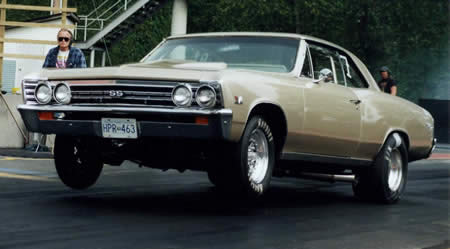
Along with my 1983 VW GTI, this Chevelle will go down in history as one of the most involving experiences in my automotive/mechanical life. It is hard to capture the near endless and evolving details that encompassed the 5 years of building and racing this car, in all of its various forms. I invested a lot of money, but most importantly, thousands of hours of my time over this period, and it is really too bad that I sold this car off in 2001 (I was burned out and sick and tired of racing). Here is the story, as best I can tell it, of my 1967 Chevelle SS396 . . .
Perhaps my American muscle car experiences with my Ford Mustang just weren't enough to fully satisfy my lust for good ole' fashioned drag racing power and 60s nostalgia. Perhaps I was actually trying to purchase a clean numbers-matching collectible car. In any case, shortly after I found this car on Vancouver Island in the summer of 1996, I had it almost completely apart (after it had won 'best of show') looking for ways to 'improve it' while keeping it essentially stock. My mechanic told me after the engine tear down that it wasn't a '396' big block from 1967 after all, but rather a slightly later model '402' engine from 1970 that had been installed. This wasn't an original big-block powered car - but rather a Canadian (Oshawa built) 6 cylinder Chevelle that had been converted.
What to do with a clean unmolested car that was not really collectible after all? I decided that it needed to be stripped down to bare sheet metal, prepped thoroughly to match the original SS396 body moldings, apply a fabulous new paint job, install a fresh interior and a full mechanical update with a modern suspension, big disk brakes, new 502cid big block engine, transmission and rear-end - and the goal was an honest, street legal, BC 'air care' smog approved 650hp out of a warmed over Chevy 502cid crate motor with an additional 300hp on call via a nitrous port injection system, running thru a TH400 3 speed trans into a beefy Dana 60 rear-end with ladder bars.
Click here for my initial '67 SS396 Project Specifications and 502cid Engine Dyno Results Document
By 1999 we were ready to roll with a mint condition road capable car (painted no less by Mercedes Benz in Vancouver - with more than $30,000 in paint and prep work involved) that ran an honest 10.5s @ 128mph 1/4 mile time 'on the motor' its very first time out at the race track. And, yes, it passed the local 'air care' smog test in this 'mild' state of tune as well. Within a few weeks, and the use of some nitrous we were running in the 9s.
To put my Chevelle's initial track performance in perspective, you need to check out what other super cars are capable of in this article: Road & Track - 1320 Shootout - June 2000. Current exotics run 0-60mph in under 4s and can cover the 1/4 mile in the mid 11s range - which means that my Chevelle, in its mildest form, without using any nitrous, literally could destroy all comers on the street with a 0-60mph time of around 2.5s. In its later forms, the Chevelle would run 0-60mph in under 2s.
With stellar results like these, I was motivated to see if I could push the car into the 8s with bigger cylinder heads, a bigger cam, and a matching intake and carb (pushing the motor to around 770hp on its own), and a 500hp 2 stage nitrous system, for a total of 1270hp. Well, we certainly ran a lot faster at the track later that summer, posting our best time slip of 9.12s @ 150.7mph, but it was a real handful to drive, required a parachute to stop safely from those speeds, and in the end it broke the rear suspension ladder bars.
We decided to step it up a lot more in 2000 with a completely new race-only 548cid motor putting out 860hp 'on the motor', a new 600hp progressive controlled nitrous system, a full-race 2-speed powerglide transmission, 4-link rear-end, bigger tubs and slicks, and a new roll cage as well. Funny thing was, after all of this investment of time and money, the car was not that much faster (9.06s @ 157mph). A lot of the blame was due to our switch to the 2 speed transmission with a loser 8" converter, as opposed to our prior 3 speed trans and 10" converter, and the difficulty putting all of the additional power to the track (we produced a lot more power, likely over 1400hp, but it was nearly useless). It turned out that the prior setup was the ideal balance between street use and strip performance. A lesson learned.
I started to return the Chevelle back to being a true street car with a smaller cam shaft, the addition of an electronic fuel injection system and a 3 speed trans and 10" converter, with the intent of making it much more drivable and limiting the total power to around 1100hp, but with my heavy investment into the S-10 truck drag racing program in 2001 and mounting technology company business pressures back at the office, I ultimately threw the towel in at the end of season and sold off my entire racing program and walked away from it all.
To see a ton of photos, videos, see performance measurements/specs, and hear more about this street/strip car, see my 1967 Chevy Chevelle SS396 web page.
2000 Mercedes Benz E55 AMG (owned 2000-2004)
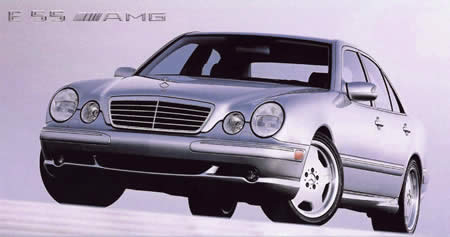
Mercedes acquired the legendary German AMG aftermarket tuning company in 1999 which was responsible for the creation of the original AMG Hammer (see the AMG Hammer review in Car Magazine, December 1986) amongst many other rod rodded Benz monsters over the years from the late 1960s onwards, and it was the perfect answer to BMW's M division which was gaining in popularity with the go-fast baby boomer set. The first Mercedes produced AMG 'hammer' was this 2000 E55 and it took the automotive world by storm with its 4.8s 0-60mph factory stock time slip and 4 fully functional doors for use by family members and business associates - the perfect gentleman's hot rod.
While it was a bit hard to do a good smoky burnout (there was just enough torque under the right conditions to light'em up - unlike the later 2004 E55 which would shred the tires any time you wanted to), the normally aspirated 5.4L engine was a nicely balanced piece. The car was relaxing to drive at a fast or slow pace. My wife rates this as the nicest car I have ever owned. But I had to upgrade to the newer 2004 supercharged E55 when it came out because the idea of owning a 500hp 4 door sedan just seemed too cool to pass over. As I said below, ultimately Mercedes ruined the AMG brand by providing an AMG option for literally every model they made, thereby forcing dedicated gear heads like myself, who are steeped in high performance motoring traditions and concepts of exclusivity, to share their rides with anyone and everyone who walks into a dealership with a big wallet.
To see more photos, read magazine reviews, and hear more about this 'original' AMG car, see my 2000 Mercedes Benz E55 AMG web page.
2001 Chevy S-10 Pro-Stock Dragster (owned 2000-2001)
While this was the fastest and most expensive vehicle I have built/owned (using all pro/trick racing parts - see below), I really don't know why I allowed myself to get into this project - which was a somewhat excessive foray into high-end Pro Stock (and Top Comp) drag racing. My vendor/partner in the fabrication and racing of the Chevelle, Danny Beaudry/Pro Gas Engineering, really wanted to do this project together with me, and looking back on it, while it made some sense to leverage the trailer, motor home and tools that we had assembled as part of the Chevelle effort, there was no historical connection between myself and this S-10 dragster and no street-use angle to it either. Going really fast is a neat idea, but it is a lot of work and trouble too - net net, unless you are living the sport of drag racing, and have sponsors to share the financial cost, it isn't worth it at this pro/semi-pro level.
We ordered all of the trickest, costliest, and fastest pro stock parts: a $50,000 Steve Schmidt 580cid 1340hp Pro Stock engine (the engine was detuned to 1260hp by assembling it with 1.7:1 ratio roller rockers and 15:1 cr pistons rather than 1.85:1 rockers and 17:1 pistons for improved reliability and economy - we could use lower cost and more readily available C25 racing gas, rather than hard to find C44 Prostock blend) and $10,000 Proline 6000 transmission included, and got to work building the dragster over the period of 2000-2001.
It was a ton of work and money to put together a car that was to run potentially 6.9s @ 200mph in the 1/4 mile (when operated with a 5 speed manual transmission - for ease of maintenance we started out with a powerglide trans). In the mild state of tune that we initially had our S-10 setup for, it ran 7.50s @ 185+mph. Trouble was, it wasn't much fun for me (I wasn't licensed to run dragsters faster than 7.50s) and it was way outside of my comfort zone anyway - this thing was scary fast. After a few months of racing, we folded up the racing program and sold off everything, including the Chevelle. Bummer.
To see a lot of photos, videos, see performance measurements/specs, and hear more about this pure race car effort, see my 2001 Chevy S-10 Dragster web page.
2004 Mercedes Benz E55 AMG (owned 2004-2005)
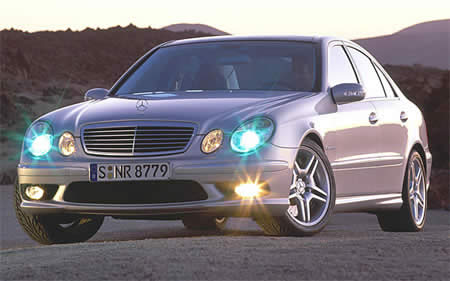
The relative peak of insanity in regards to stock box 4 door sedan muscle cars is epitomized by this vehicle. Who needs 500hp in a family sedan? - apparently everyone does these days. Looking back to the original AMG Hammer, this car makes an even more serious statement about walking softly while carrying a big stick - the problem is, since 2004 Mercedes has AMG'd literally every last model it makes, and while they are all go-fast sleds, there is nothing exclusive about these cars any longer. RIP, AMG.
The factory 0-60mph time for this 2004 E55 AMG was 4.2s and my one and only trip to the drag strip with this car netted me a 12.2s/116mph time slip in 28 degree C heat. I bought slicks for it to see if I could record an honest 11s second time slip but ended up selling the car to 'go green' with my Honda Hybrid (below). This 2004 E55 AMG was truly a bad-ass factory car. 5 years earlier this car's capabilities would have been at unheard of performance levels, putting it in a very exclusive class of 'one'. But, by 2005 there must have been a dozen Mercedes Benz models that could pull off very similar #s, and then there were the hopped up BMWs, Porsches, Bentleys, and so on. Today, having 600hp under the hood of your factory ride isn't anything to write home about.
Who ruined the party? Maybe the advancement of technology did. Maybe the affluence of a whole generation of baby boomers who want it all, materialistically, did (without knowing anything or caring much about cars themselves). I don't know. But I have personally always wanted exclusivity in my choice of ride, and along with the current issue of global warming, it is hard to get me excited about owning any high performance car any longer. I long for something new, different, and special. It will likely come in the form of a pure electric sports car like the Tesla (www.teslamotors.com), or some hybrid gas/electric sports car like the Toyota FTHS (see Motor Trend, February 2007). Count me in for one of those . . .
Speaking about the 2004 E55 again, in some ways, the best of the 4-door sedan factory muscle cars was the previous 2000 E55 version. Why? Because an AMG Mercedes was still a new idea back then in 2000, and owning an E55 AMG was practically the only choice if you wanted to drive such a vehicle (or you could build your own the way I did with my 1995 Dinan 540i though).
I am encouraged by the prospects of clean high performance automotive fun re-emerging towards the end of this decade, with electric and hybrid gas/electric (capacitor) powered sports cars. Mixing electricity with gasoline has the potential for explosive power with 3s 0-60mph times and more - all with the ability to save the planet at the same time. That is what I am now waiting for before I'll wade into the high performance sports car arena again. In the mean time I'll stick with weekend open-wheel Formula 2000/3000 racing, and otherwise look into small displacement light weight sports cars like the Lotus Elise which have a much lower environmental foot print.
To see more photos, videos, read magazine reviews, see performance measurements, and hear more about the minor modifications I made to this car, see my 2004 Mercedes Benz E55 AMG web page.
2005 Honda Accord Hybrid (owned 2005-2009)
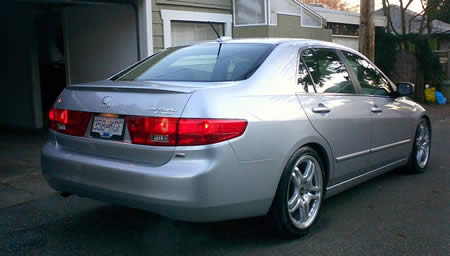
Going 'green' with a high performance hybrid that achieves 7.9L/100kms in the city and 5.9L/100kms on the highway is what this vehicle was all about. It pulled 0-60mph in 6s thanks to its 240hp 3.0L V6 engine and 15hp electric motor (which added a full 100ft-lbs of torque right off idle - which you could really feel) and rode on competition Tien coil-over springs and shocks about 2" lower than stock on a set of 18"x8" BBS rims and 225/45 series Michelin Pilot Sport tires. Lighting was also upgraded to Bi-Zenon low and high beam halo units, and braking was improved with a set of Brembo front slotted and cross-drilled rotors. The stock leather trimmed interior with an impressive stereo and heated, multi-way adjustable seats, left little to be desired as well.
To see more photos, read a magazine review and a personal Vancouver Sun article on 'going green' with this vehicle, and hear more about the modifications I made to this 'green tech' car, see my 2005 Honda Accord Hybrid web page.
2010 Toyota Prius Hybrid (owned 2009-2012)
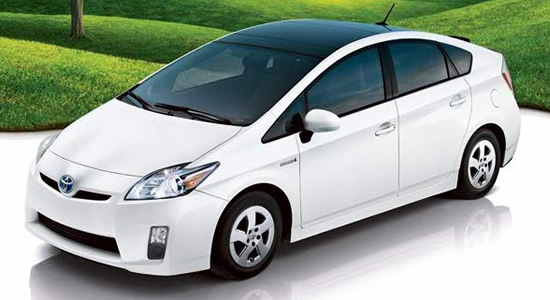
Going really 'green' meant moving to a 'plug-in' hybrid design and that was the genesis of this vehicle purchase. Starting with a factory 60mpg fuel economy rating . . . I intended to convert this vehicle into a 100+mpg science project and actually set about acquiring all of the additional batteries and electronics components necessary for the project when Toyota announced their intent to put their own idea of the plug-in Prius into production in 2011. I stopped the project and waited. Well, it took them another year, partially due to the Tsunami impact, but I managed to eventually get one - see below ...
To see more photos, read magazine reviews for this vehicle, see my Toyota Prius Hybrid web page
2013, 2015 Toyota Prius Plug-In Hybrid (owned 2012-2014, and again 2015-2017)
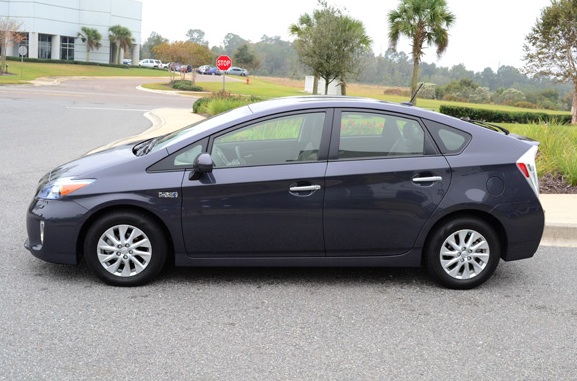
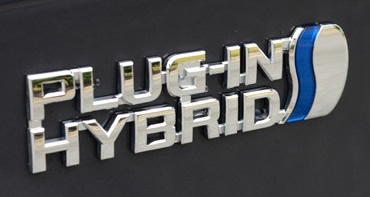
Smooth, quiet power. But a bit like driving a taxi around all day ...
Ultimate 83 GTI (owned 2012-2020)
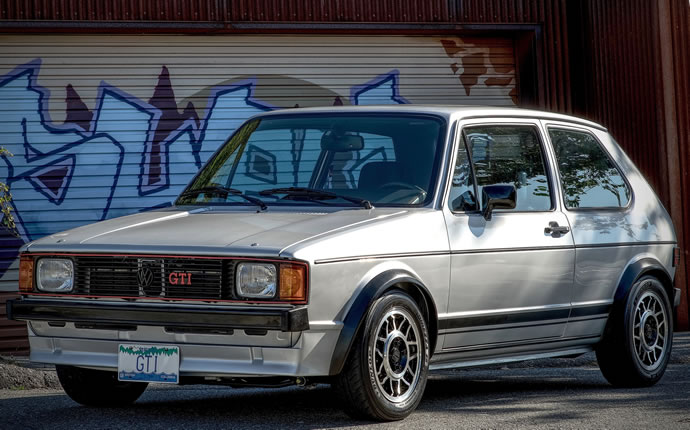
The project goal was to create a ‘cost is no object’ Ultimate VW GTI by going back to the simplicity of the VW Mk1 with its tossable fun factor and old school mechanical connection between the driver and the road, and then working to improve chassis rigidity, and cranking up acceleration, corning and braking performance, while also sneaking in modern creature comforts.
As guiding references to this project effort, there were 2 great Mk1 GTI variants back in the day: the bad-ass Callaway stage 2 turbo; and the ultra-rare Oettinger 16s which was a factory supported car in Europe in 1981. To me the lighter 16s was the way to go – but in a more modern format, borrowing the Mk2 16V cylinder heads and keeping everything close to ‘stock’ configuration while maxing out all performance parameters.
The result is a car that looks inside and out like it just rolled off the 1983 VW showroom floor with a totally stock looking exterior and interior, but being a true ‘Wolf in Sheep’s Clothing’ under the covers – resulting in a totally cool retro driving experience that can outrun a modern VW Golf R or a Porsche 718 Cayman S on the street or the track.
Performance: 240hp + 1950lbs = one very quick little car: 0-60mph in <5s, 0-100mph in 11s, and >1g corning and braking on street tires (a progressive nitrous system adds up to 100hp more).
Creature comforts include electric windows; forward and backup cameras – displayed on the rear-view mirror; adjustable heated seats; push-button engine starting; electronically adjustable brake pedal pressure; 1200W RMS bluetooth audio system with a hands-free cel phone interface; full data logging with 2 axis accelerometers; convex side mirrors; touch-screen digital dash (analog and digital gauges); electrical A/C system with central dash vents; infinitely variable blower speed, a stunning ‘new’ OEM sunroof; all original NOS seat fabric with sport-firm foam padding front and rear; custom leather wrapped OEM steering wheel, adjustable pedals (perfect for heel and toe shifting), driver adjustable brake vacuum assist, plush OEM grade carpeting, floor mats and sound deadening insulation.
When driven by Kees Nierop (former Porsche factory race driver at Le Mans) at the Vancouver Island Motorsports circuit (a tight 2.3kms 19 corner racetrack) the Ultimate 83 GTI was faster than a 2018 Porsche 718 Cayman S (also driven by Kees). Project goals met!
For more information, see my extensive webpages starting here: Ultimate 83 GTI Project Overview
2018 Audi A3 Etron (owned 2017-2021)
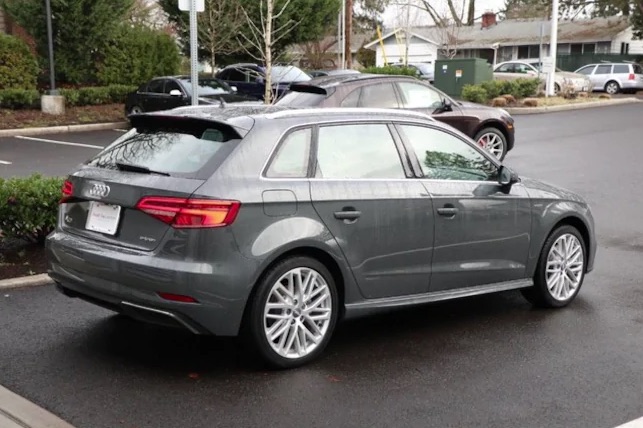
36kms of electric range, 0-60mph in 6s, 680kms gas range, tight handling, more stylish and better fit and finish than the Prius - I loved it. Power comes from combining a 1.4L TFSI, which outputs 110 kW (150 hp) and delivers 250 Nm (184.4 lb-ft) of torque, with an electric motor that produces 75 kW and 330 Nm (243.4 lb-ft). The system outputs a total of 150 kW (204 hp) peak.
2014 Radical SR8-RX (owned 2018-2019)
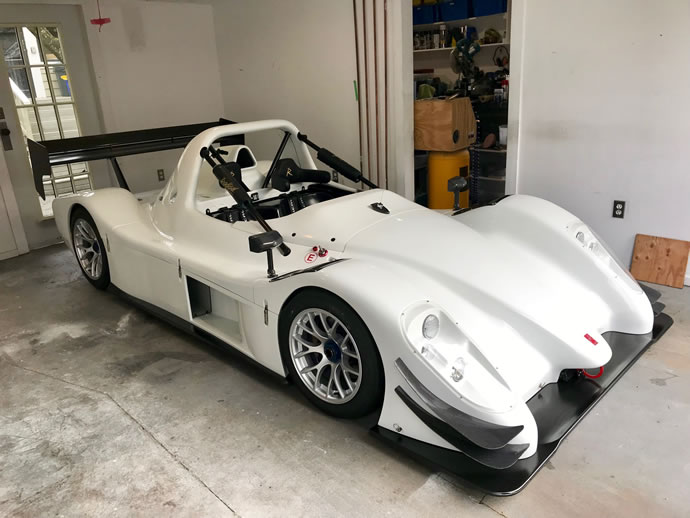
1400lbs, 430hp at 11,000rpm from a 2.7L V8, 2.5g of cornering force, enough down force at 100mph to drive upside down. This particular car holds the record at the Area-27 circuit in the interior of BC and this model famously held the lap record at Nurburgring @ 6:48 sec for a number of years. I bought this car with 14hrs of run time on it and refreshed it with the intent of running it at the Vancouver Island Motorsports Circuit (https://islandmotorsportcircuit.com/) where I held a membership but they cancelled all memberships after a dispute over noise with the local municipality. I got my Formula 3 SCCA license in preparation for driving this insanely fast car and then threw in the towel and sold it after it became clear that my dream of running it along side my Ultimate GTI at VIMC was not longer possible.
To see more photos and information on this vehicle, see my Radical SR8-RX web page
2021 Tesla Model 3 Performance (owned 2021-2024)
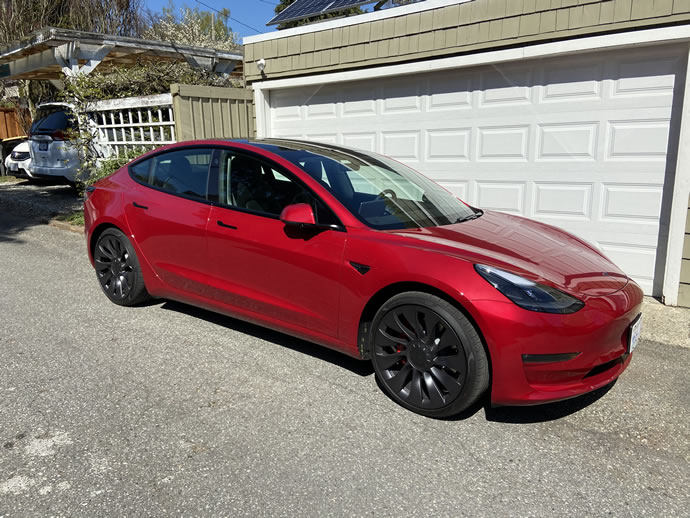
508kms of electric range, 0-60mph in 3.1s, 11.5s@116.5mph 1/4 mile time from its dual motors (wheel dyno measurements: 523hp/707ft-lbs so using a typical 15% gas powered car transmission loss estimate that is the equivalent of 615hp/832ft-lbs), tight handling, dead quiet - this was the best (and fastest) street car I had ever owned until it was replaced with the 2024 model - super quiet, confident, stiff chassis, excellent grip and dyanmic handling/balance.
Here is a great Road & Track review of this model: https://www.roadandtrack.com/new-cars/road-tests/a22625274/tesla-model-3-performance-track-test/
For a performance comparison with my Radical SR8-RX race car and a 2022 F1 car, see this excel file
2024 Tesla Model 3 Performance (owned 2024-present)

0-60mph in 2.7s, 10.8s@127mph 1/4 mile time - wow! Compared to the 2021 model it has better road manners from its adaptive suspension, quieter - less road and wind noise, more supportive/cooled seats, lighter rims and 275/30-20 P-zero tires on the rear vs 235s for the 2021 model, so better traction coming out of the corners under power. In short: a beast that is a pleasure to do daily drives in.
Other vehicles in my life over the years . . .
Toyota Land Cruiser & Datsun Pickup (borrowed from my dad's office, 1980, 1982)
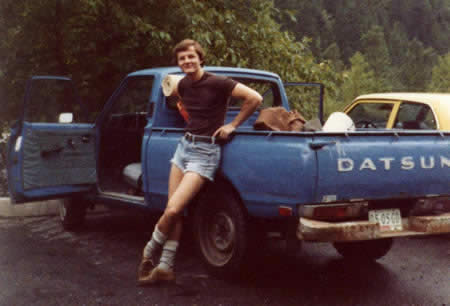
Cheryl and I were seen driving around town in this somewhat beaten up pickup truck and also winding our way up to Whistler for some R&R.
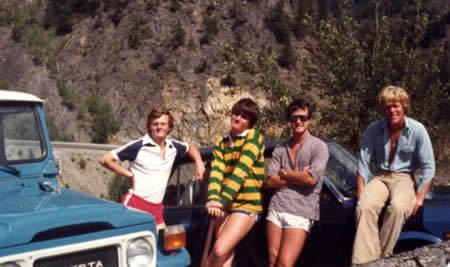
I also managed to snag the company diesel powered Toyota Land Cruiser for a few trips around town as well as a longer trip up to Penticton for our final 1982 summer party with the old Pt. Grey high school gang (we did make future trips together to different destinations: Washington State (1983), Alice Lake (1984), and Bowen Island (1984 and 1985).
1984 Mazda GLC 4-Door Sedan (owned 1987-1995)
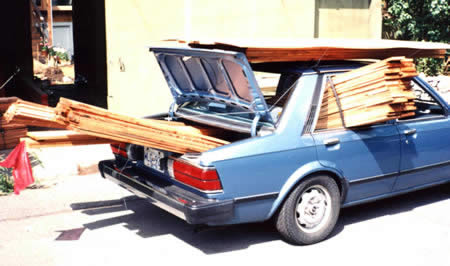
Cheryl needed a car for use around town after we got married so we picked up a fairly reliable Mazda GLC, which was recruited for all of the odd jobs such as hauling lumber to our new home for reno projects.
1995 Toyota Previa LE SC AWD (owned 1995-2003)
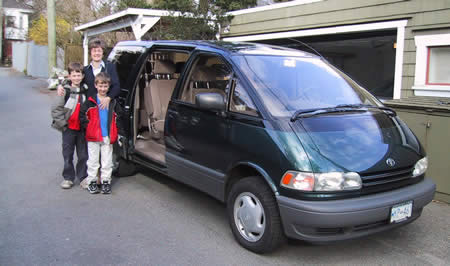
The day after Colin was born, Perry and I went to pick up our new supercharged AWD Toyota Previa - if we were going to have a minivan, at least it was going to be a high performance one. This particular vehicle had the all-wheel-drive system adapted from the Toyota Celica All-trac-turbo - and it really worked - full time intelligent, sensing AWD. A killer solution to address the challenges of winter snow days and trips to Whistler.
2003 Toyota Sienna XLE AWD Limited (owned 2003-2007), 2007 Toyota Sienna XLE AWD Limited (owned 2007-2010)
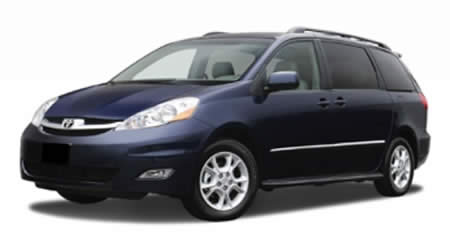
As the only all-wheel-drive minivan on the market, the Sienna XLE AWD Limited was both practical and has amazing luxury - and yes, great winter road condition traction to boot. Ever since we fell in love with Toyota's original AWD Previa, we stuck with the AWD minivan concept until our kids grew up. It is a leather trimmed, DVD experience for everyone - complete with laser cruise control and 120VAC power for those additional home accessories you might want to bring on the road.
I am personally not an SUV fan when it comes to making a family hauling transportation choice. Nothing beats a minivan for roominess and practicality when you have a young family - you just have to get over the idea of looking like a soccer mom.
2011, 2014 Toyota Highlander Hybrid AWD Llimited (owned 2010-2013, and again 2014-2017)
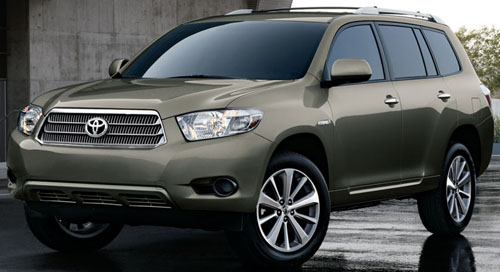
This SUV with its hybrid drivetrain and 3rd row seating was the perfect choice for our family as we transitioned away from kids at home over the next few days towards being fully 'empty nesters'. My wife can run around town in this SUV on week days, sipping on gas, and surrounding herself in total luxury, while weekends and summer road trips allow us to pile everyone into the car and have room to spare.
2018 Toyota Highlander Hybrid AWD Limited (owned 2017-present)

Larger, more powerful, seating 8 adults, better handling and road manners - still perfect to haul around our family when our adult boys are home visiting, and otherwise acting as a tow vehicle for my race cars.

